#sub-marsupial
Text
good morning everyone feat feel the ghost of my tongue wherever the fuck u want it and have a lit j! it's a beautiful morning to be alive<3
#positivity#hi everyone#tiny bunnies#all the puppies#kittens and pangolins and marsupials oh my#you#@u#ftm nsft#t4t nsft#ftm sub#ftm ns/fw#ftm pet#queer nsft#kaedthoughts.pup
9 notes
·
View notes
Text
What animal form would your daemon take? by firstginger
Marsupial
Your daemon would take the form of a marsupial! Those who have marsupial daemons are protective and giving people who typically have an unusual or quirky perspective on life. They are creative individuals good at inspiring their loved ones, notably quiet until something riles them up.
Brushtail possum
Your daemon would take the form of a brushtail possum! You are a private but honest individual who is known to be unobtrusive. More so than others with marsupial daemons, those with brushtail possums are traditional people, confident and self-assured when they're in their comfort zone but sensitive otherwise. They are low energy and calm, not terribly ambitious and more so value a simple life. If you're happy with your daemon's form, give them a name. Daemon names can be any length but are typically something unique. Play around with names and sounds until you find something that speaks to you!
#marsupial#brushtail possum#24 sub-results for the marsupial results#I quiz Uquiz We quiz#uquiz#uquiz quiz#uquiz link#his dark materials
3 notes
·
View notes
Photo
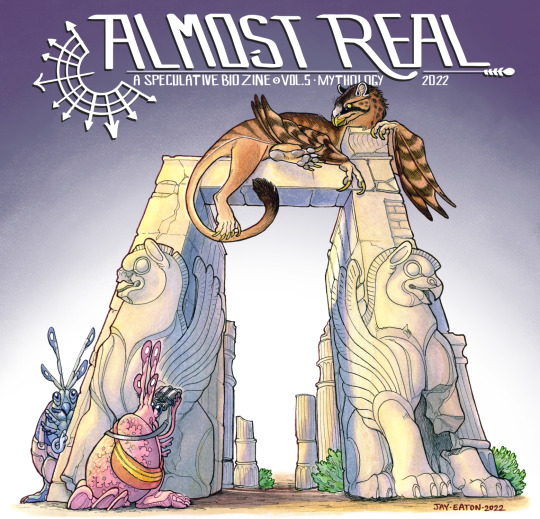
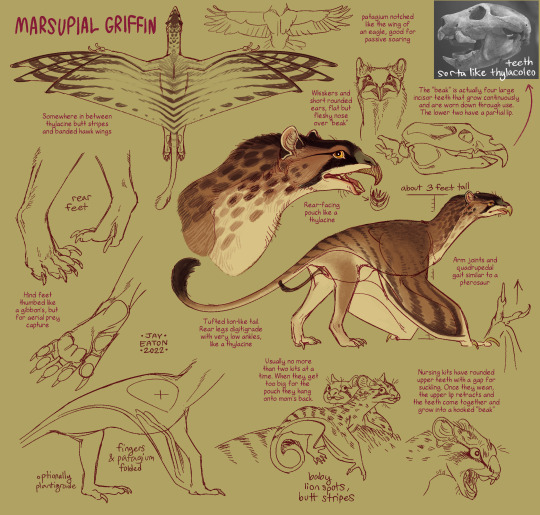
This year’s issue of Almost Real: A Speculative Biology Zine is mythology themed, so I wanted the cover critter to be a weird take on an extremely recognizable legendary beast.
The marsupial griffin is my shot at that, a large flying carnivore with a rear-facing pouch like a thylacine. Its unusual front incisors are continuously growing like rodent teeth, but exposed like a beak— nursing young have a gap in between them, but as they wean into sub-adults the gap closes and the teeth grow to a sharp hook for tearing into meat and carrion. Their thumbed hind feet somewhat resemble a primate’s, but with a set of sharp talons for capturing and gripping prey.
Our cover for this volume was illustrated by @ibenkrutt, who really knocked this design out of the park. If you’d like to support our contributing artists and acquire the zine, you can check out the campaign over here!
https://zoop.gg/c/almostrealvol5
5K notes
·
View notes
Text
CoD Baddies as Bears!
What if the bad guys were also bears! Part 3
See part 2 and 1 for 141 and good guys as bears
Even more bear facts because bears are love, bears are life. 🐻🐻❄️🧬
Makarov: Ussuri Brown Bear "Russian Grizzly Bear"
Ursus arctos lasiotus
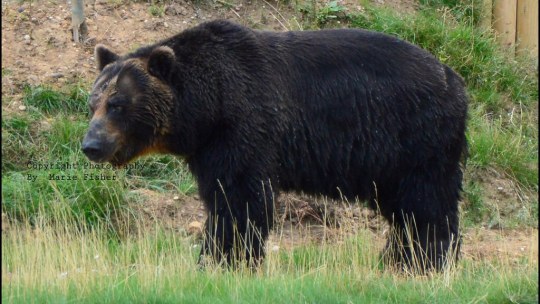
Also known as the Ezo Brown bear or Black Grizzly bear, this subspecies of Eurasian Brown Bear is one of the largest, with some individuals approaching the Kodiak Bear in size.
Similar to the Kamchatka Brown Bear, it differs with an elongated skull, longer nasal bones, elevated forehead and is darker in colour with some individuals being pure black.
Siberian (Amur) tigers and other bears are it's only natural predators, with documented tiger and bear interspecific competitions. Ussuri brown bears will often scavenge tiger kills and or kill smaller tigers, while Tigers are known to hunt young and sub-adult bears (bears making a significant portion of their diet).
Graves: Louisiana Black Bear
Ursus americanus luteolus

A subspecies* of the American Black Bear (U. a. americanus), the Louisiana Black Bear has been historically found in Louisiana, Mississippi, East Texas and Arkansas.
It is not substantially different from the American Black Bear, though it has a longer, flatter, narrower skull and larger molars in comparison. It's colouration is typically black, though some individuals have been known to be brown/red-brown cinnamon. It is Louisiana's official state mammal.
*The validity of this subspecies has been repeatedly debated.
Valeria: Sloth Bear "Indian Bear"
Melursus ursinus
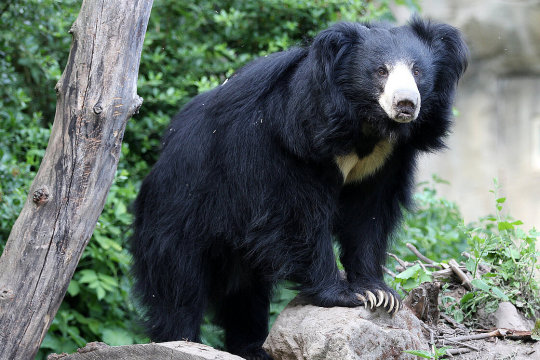
A native species to the Indian Subcontinent, this medium sized bear feeds on ants, termites and fruit. It is also called the "labiated bear" due to its long lower lip and palate which is used to eat insects.
It's fur is pure black aside from the white "Y" or "V" patch on its chest though this can be absent in some individuals. They are similar in size with the Asian Black Bear though distinguished with it's shaggy mane, white 'sickle' claws, and rangier build.
This species is the most aggressive to humans with the largest number of recorded attacks due to a combination of close human cohabitation and a theorised predisposition to aggressive behaviour from constant attacks by tigers, leopards, rhinos and elephants.
Captain Williamson in his Oriental Field Sports (1819) wrote of how sloth bears rarely killed their human victims outright, but would suck and chew on their limbs till they were reduced to bloody pulps.
They are not known to be man eaters despite attacking humans. One individual in Mysore (Mysuru), India was recorded to have killed at least 12 people and mutilated 24 before it's death in 1957.
Shepherd: Koala "Koala Bear"**
Phascolarctos cinereus
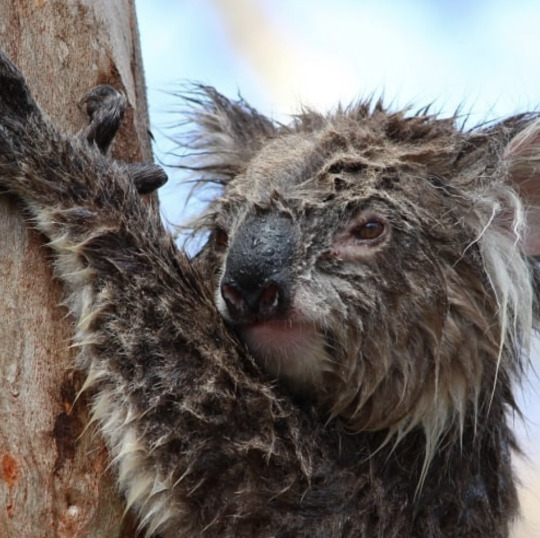
**not a bear
An arboreal marsupial native to Australia that feeds primarily on Eucalyptus leaves. Koalas are asocial with bonding only taking place between mothers and dependant offspring. They are largely sedentary and will sleep upwards to 20 hours a day.
The word "koala" came from the Dharug word "gula" - no water. The 'u' sound was originally written phonetically as 'oo' and then became 'oa'. The three syllable pronunciation may be erroneous as a result.
White settlers adopted the 'koala' indigenous loan word in reference to the animal, where it was also referred to as, the "native bear", or the "koala bear" due to its supposed bear-ish resemblance.
+
Info from Wikipedia. Please let me know if I screwed up somewhere. 🐻
#cod mwiii#cod mwii#call of duty modern warfare#call of duty#vladimir makarov#cod makarov#phillip graves#graves cod#valeria garza#valeria mw2#general shepherd#bears#bear facts#cod mw2#cod mw3
37 notes
·
View notes
Text
And that's a thousand followers, guys!

So to celebrate here's a five-in-one oneshot art compilation (fiveshot?):

'The small subcontinent of North Westerna, off the coast of Arcuterra, is in many ways a glimpse of the past. The last hammoths, stunted survivors of the Glaciocene, have begun their return to glory, with some species shrinking to miniscule scales, but others growing bigger, coming to approach the sizes their forebearers once were. But with bigger herbivores thriving in abundance, bigger carnivores follow suit--like the pterowrex, a macropredator descended from the pterowrist that can reach up to 700 kilograms in the largest and heaviest females. Like their predecessor, the pterowrex is a heavily dimorphic species, with flighted males having specialized into stork-like ground-hunters while far bigger, flightless females being megafauna hunters and the Temperocene hammoths' primary predator. Fortunately for this particular hammoth herd, however, this large female pterowrex is sated and not hungry, and is content to let them pass and watch from a distance, with scarcely any hostility, at least for the time being.'
-------
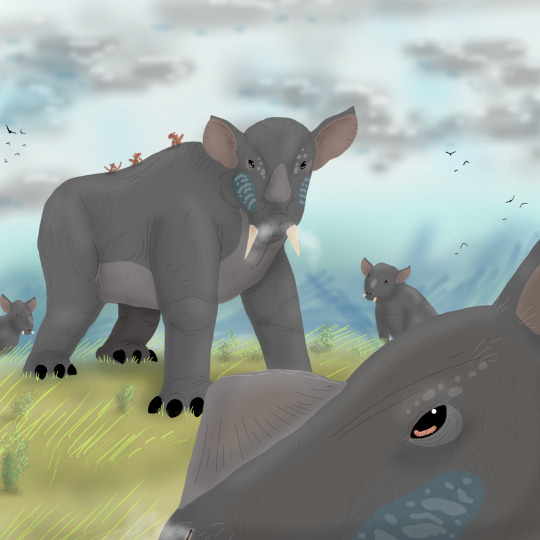
'The abundant valleys and grasslands of the northwest peninsula of Arcuterra echo with deep, reverberating calls, as herds of elephinos--largest of the extant piggalo-- court and compete for mates during the rainy season when food is abundant. Male elephinos are distinctive with their pale bluish cheek patches, which turn more vibrant the healthier they are, and with their blunt, keratinous nasal bosses used for inflicting blunt-force impacts onto rivals. Their stubby, straight tusks, predominantly used for digging up and uprooting vegetation, are far too short, delicate and valuable to be utilized in combat, and at eight tons in the biggest males, fighting is energetically expensive for such large animals: thus favoring males with displays that can assert their dominance without costly, and risky, fighting.'
------------
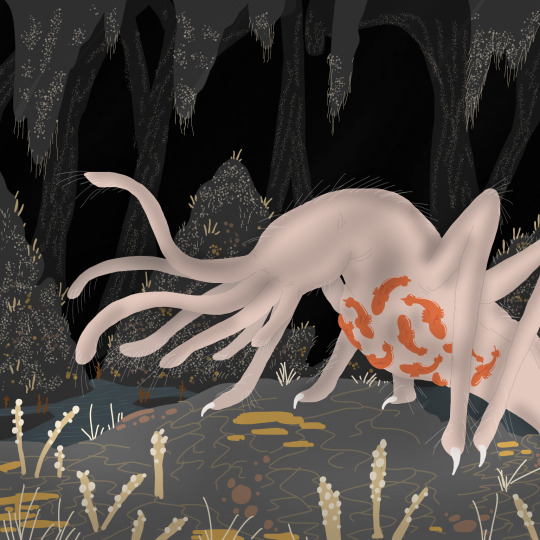
'Deep in the dark caves of the Sub-Arcuterran Cavern System, a small daggoth scurries among the fungi, mocklichens, meatmoss and microbial mats as it carries a remarkable cargo: a collection of tiny, underdeveloped offspring attached to the smooth, bare skin of its underbelly by sticky oral secretions. These, much like the newborns of marsupials, latch on to their mother's mammary patches and feed off on milk secreted out by the skin by many scattered glands as opposed to a more typical teat. Unlike a marsupial, however, they only remain attached for a few days, after which they drop off and are able to live independently from there on, burrowing into clumps of meatmoss or being deposited there, until they are sufficiently developed enough to begin foraging for small prey on their own.'
---------

'Next of kin to the fully-aquatic cricetaceans, the jousting bayvers are an unusual clade of tusked marine pondrats with a very complicated history and a fickle relationship with the sea: having evolved to be fully-aquatic like the cricetaceans several times, but also have returned to a semi-aquatic life, with the help of strong shoulders and flexible wrists, at least twice in their evolutionary tree to a lifestyle more comparable to basal bayvers filling pinniped-like niches. The most widespread of these is the narwalrus--a fairly large species that can reach a weight of almost two tons, and is equipped with a single forward-pointing tusk derived from misaligned asymmetrical upper incisors that find use in probing for food on the sea floor, prying open bivalve shells, and being used for defense or territorial conflict. An abundance of marine predators such as phorcas may have played a role in their re-evolution of terrestrial mobility, able to clumsily but successfully flop their way ashore to escape the reach of their water-bound enemies.'
--------
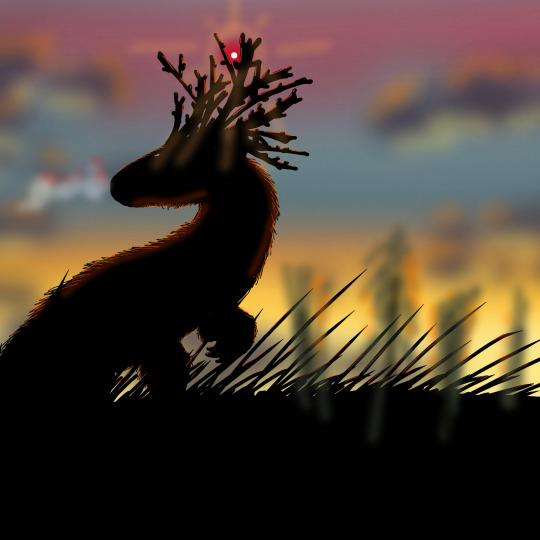
'Beta's crimson rays shine through the convoluted, tangled horns of a clusterbuck: one of the largest of the stagotaurs that now flourish as Arcuterra's predominant megafaunal browsers. Heavy and slow unlike most typical podotheres, clusterbucks have in many ways returned to the form of their Glaciocene ancestors the drundles: save for the elaborate growths on their heads equipped with bony cores but further expanded by branching keratinous sheaths. These structures are far too fragile to be used as weapons, and indeed their size and forelimb claws are sufficient enough to deter attackers. Yet their horns persist as a sign of fitness, and as a key to their reproductive success that makes them far more attractive to females: even if they prove cumbersome and unwieldy to their owners in the long run and end up trading off longevity for fecundity.'
------------------
#speculative evolution#speculative biology#spec evo#speculative zoology#hamster's paradise#1000 followers milestone
64 notes
·
View notes
Text
The gregarious Gligglae
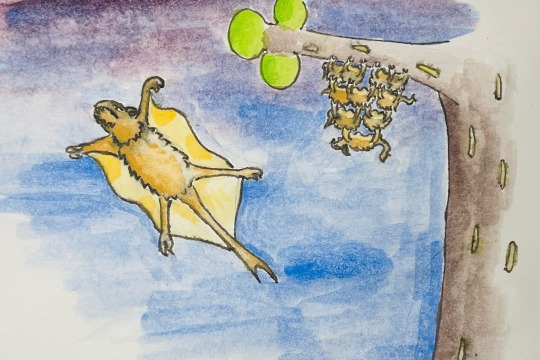
My response to this week's BestiaryPosting Challenge from @maniculum!
Initial pencil sketch for proportions, Sailor fude nib fountain pen with Rohrer & Klingner Sepia ink for the lines, then Derwent Inktense paint with waterbrush for the *gasp* colour!
I wanted to try something a little different this week, and I've been wanting to try out the inktense paints for a while, so this was a good excuse. Heavy influence from Ken Sugimori's Pokémon illustrations, not least since I feel there's a weird parallel between Medieval bestiaries and the Pokédex... I feel like the bestiary authors and Pokémon professors are both doing the best work with the information they've got, whether that's provided by a naturalist who died in 79AD, or by over excitable children forging their way through The Long Grass...
The water brush is definitely going to take some getting used to (very easy to squeeze out too much water!), and the R&K ink is a little less waterfast then I was hoping (necesitating a little bit of going back over some of the lines after it was dry), but it was an interesting learning experience. I also feel like If I'm going to be working on a small (sub-A5) canvas, it might benefit me to find a finer nib, or at least try and make some of the detail bigger! :D
Reasoning under the cut...
"The Gligglae, a lowly animal, gets its name from the evening, when it emerges."
- A lowly creature makes me think it's a small critter, reinforced by the knowledge that it clusters together in groups. We have some purple overlaying the blue of the sky, to indicate that dusk is falling and the Gligglae are becoming more active...
"It is a winged creature but also a four-footed one, and it has teeth, which you would not usually find in birds. It gives birth like a quadruped, not to eggs but to live young. It flies, but not on wings; it supports itself by making a rowing motion with its skin, and, suspended just as on wings, it darts around."
- Okay, does it have wings, or not? I suppose I could have interpreted it as having wings but not using them, which would have been interesting, but my thoughts inevitably turned to flying squirrels adn sugar gliders; floating in the air using a 'rowing motion with its skin' sounds like patagia... What with everything else and vivipary, I was definitely leaning towards something fuzzy and mammalian by default; we have no indication about the diet of this critter, so I could have gone either way with its teeth, but I ended up thinking that pointy insectivorous/marsupial teeth made more sense given no mention of rodents by the author (and they were also easier to draw, which didn't hurt!).
"There is one thing which these mean creatures do, however: they cling to each other and hang together from one place looking like a cluster of grapes, and if the last lets go, the whole group disintegrate; it is an act of love of a sort which is difficult to find among men."
- Cute! :) On the right, we can see a cluster of Gligglae starting to wake up. They are holding on to each other, and the ones at the bottom (or top, I suppose) of the pile are holding onto a branch of a tree - they must be able to hold on pretty tight in order to support the weight of all their friends, hence the large, prominent claws on each of its limbs...
Thanks again for the prompt @maniculum, and I hope you're starting to feel better!
7 notes
·
View notes
Text
Of 'Grumbats'
When I started picturing this, I imagined an orc, then a lizard type thing that would refer to their race as "brother" or "sister" but then moved onto the idea of a mole-rat. They are technically called "Grumbats".
There is at least one queen, they produce copious amounts of self-fertilised eggs. They bury themselves underground, hibernating mentally, just producing eggs in a main-nest.
These creatures have rat-like, mangy, dirty, vermin features. When in harsh environments they develop a hunch full of fat stores but usually they stand up like a humanoid.
They aren't purely biological, they have a magical element built into them. They have two vertical pouches on their torso when they can incubate an egg (seedling) through to a joey (puggle). After that, although tiny, they will travel outside, either upon their parent or waiting in a sub-nest.
Although they treat each other as siblings (except a queen) they ARE capable of being different individuals, not clones, yet sharing traits from those that raised them. In fact, some believe that there is some kind of magical transference that occurs whilst in egg form that influences the potential of the joey that emerges.
I was imagining a stargate scenario when they don't really reproduce but have marsupial features. They do not feel complete until they have an egg that they can raise
Some individuals can almost come out as carbon copies of those that raised them, keeping their legacy alive. It's almost as if someone saw the race of tortles and devised a way to improve upon it.
Queens have six pouches where they can incubate eggs. This way she can generate protectors, tenders, hunters, or egg-runners, slight variations on her young.
Rather than a hunch, the queen can grow tendrils and cancerous growths upon her body by concentrating deeply or with the help of a tender. A growth can have its own pouch for incubating eggs, or it can be a fat store for times of drought, deep hibernation, or seige. The tendrils work like roots, taking nutrients out of the ground or out of the food that hunters have placed there. There is often a "stomach room" full of tendrils with rotting food stuffs lashed up against the walls or a pit with tendrils at the mouth.
A queen will quickly start developing another queen in a growth, in a far off place as a safety measure. The egg mutates through nutrients and magical energy, ready to hatch when a tendril is deliberately severed/dies off.
All, including the queen have an organ in their hand that can leech life-energy and magical energy. This is how most prefer to feed but they do have the ability to hunt, eat and digest their own prey. This leeching ability varies, depending on the specialisation they have.
In addition to queens, protectors, tenders, hunters and egg-runners... there are also digger drones, transporter drones, leecher-healers, survivor scouts, mentalists, incubators and detectors. It seems they run on a caste system that can defy their racial traits or class.
The colony has existed for thousands of years, surviving disasters, and rising from the ashes time and again. Entire armies of Grumbats have fallen, settlements and family pack lineages have ended. The line of queens has never been broken though, her young rising from the soil. Even though these intelligent creatures have been here long before men, orc and elf, they are still considered as disease-ridden animals by many. Their marsupial faces, a lack of their own written culture or language, and the squalor they can survive in does not help with this stereotype.
The grumbat is a mix of HR Giger's Alien, the Saarlac, Stargate's Jafaa, Predator hunters, Tolkien's orcs and the Labyrinth's goblins. It allows for body horror, and fast-breeding hives of enemies, yet can be an underdog ready to become a hero.
2 notes
·
View notes
Text
Sling Set, 2 February (Last of the Marsupilamis, part 3–Summary)
One moistened mid-August, Joan and Megara flew to Bolivia to pick up rare tree turnips on a remote village in Aguapiche for her cousin’s boo Jack, Joan discovers the runaway Navy scientist Dr. Bluebottle and the suprising origins of this escaped convict.
{About Turnip Trees (Brassica Rapa Andanosia):
hybrid species of edible beetroot grown in parts of South America, Africa and Asia after huge monsoons and during fog seasons
soft red turnips 8-14 weeks, thick n tall Baobabs 7-16 months if left on the ground
Discovered in 1916 after an Eswatini shepherd’s wild dog dug out bunches of turnips entangled in baobab roots
Trees grow turnip buds which bomb down on unsuspecting travelers}
He was actually a Navy Blue furred Marsupilami named Blubo, a leopard chimp creature rarely seen in the wild, but their bright fur n prehensile tails were hunted down by poachers to line their rumpus rooms and socialites for apparel and accesories.
He returned to Aguapiche on the 40th anniversary of two misfortunes: his family’s disappearance and death of the real Bluebottle he was posing as, his life gone in a stampede of freed animals, which wasn’t on Blubo. His curiosity would endanger those around him,but never lead them to certain death, merely looking for ways to ease him and his animal pals.
He tracked the hunters back to their basecamp, looking for his family when his wandering eyes darted towards a sketch of his species in Bluebottle’s tent. From afar, a tweedy game hunter mistook Blubo reading his journal in the tent for Bluebottle in his Mar-Suit rehearsing his subject’s behavior when he recons the trees for more Lamis or other animals. Blubo panicked and wrapped himself in his own tail, the nerdy poacher calls out to a burly lead game hunter, alongside Dr. Bluebottle, they missed one.
He was about to put Blubo in one of Bluebottle’s SOTA thumbprint ID cages with the other animals, later revealed to be Narnians, when he freed all four of his hands and clutched onto the cages, including one with an ornery rhino. The pull was straining him, he lost his grip as the buff poacher twanged his tail like a yo-yo pulling back, but not before Blubo unlocked all the cages with his fingerprints, which were near identical to Bluebottle’s prints. The locks open, then the stampede. the hunters scattered away, one portly poacher knocked the doc back and onto the path of the stampede. Blubo was just ready to follow his family in the commotion until…CRUNCH!!!!
The last gasp of Bluebottle’s life traumatized dear inquisitive Blubo. He continued his research digsuised as him for 40 years, wearing his labcoat and clothes to conceal his blue fur and leg hands, he even concocted a formula to repress his wild side to look more dogmanish and cover his murder tracks.
Years pass, he already believed himself to be the real Dr. Bluebottle, and while working under the Navy for their secret anti-radar whale sub, stole it and began seeking notoriety thru this mishap with Glomgold and McDuck’s Savings Game. Could’ve been his Marsupi heart wanted the attention to fund some research grants into searching for Marsupilamis like him while discreetly finding the family he presumably lost after that stampede on Aguapiche.
In fact, Seeing these Turnip Trees after escaping Navel custody unlocked forgotten memories of his life as a lasso-tailed leopard chimp, swinging on the branches and bungeeing for fruit and pranking predators while unveiling some wrenching reminders of the incident. He would’ve apologized to those poachers for killing and posing as Bluebottle if he wasn’t targeted by Glomgold, and that some of the poachers were using Circene to release their canine instincts and forms.
Joan asked why he would pour his backstory on her, it was from her tail Slink’s size and :3 face that Blubo could trust Joan with his confession, both being long-tailed beasts. She aides him from a smudged leopardess (Meg after his Houba shriek disrupted her midnight makeover) and the feralized hunters returning to capture him with his rediscovered family, found alive not dead as he thought they were. Some hightail hijinks and repented sins later, Blubo sighed with contempt returning to spring & swing with his family & animal pals, relieved of a No-Shirt-No-Shoes life but keeps the doc’s lenses as primal cousins do. Just then, police choppers flydown and arrest the feralized poachers to the pound by Ed with the Alphas, Sgt. Basquait & Adm. Grimmitz. Ed got Slink’s comwatch message with Gene’s assist. Grimmitz informs Joan & Blubo he’ll confirm Bluebottle’s death in their files. Meg can give Mark the turnips, and Gene asks Blubo for cryptid research via comwatch.
#Joan’s Arc#fanon#theory#disney afternoon#jungle#marsupilami#ducktales#closet cryptid#jungle adventure#Bolivia
2 notes
·
View notes
Text



Time to introduce ourselves (the organizers) again! There's historically only been 2 of us running PPZF, & we’re excited to have some extra hands on deck this year!
📘📙📓
Jennifer Eltringham (she/her) is one of the Founders & Organizers of Pikes Peak Zine Fest. Jennifer uses zines in her work as a librarian, where she gets to talk to students about information, print culture, and why it all matters. She also takes every opportunity she can get to yell about the moon and possums, North America’s only native marsupial. She makes mostly perzines as @princess_soopers - she anticipates that her magnum opus will be a zine ode to chicken nuggets.
📘📙📓
Kels Choo @kookookchoo (she/they) is one of the Founders & Organizers for Pikes Peak Zine Fest. Originally from Hawai‘i (not Hawaiian tho), Kels started making zines in college in Chicago, and has been a full-time independent artist in Colorado Springs since 2017. Kels works as a self-publisher of comics/illustration, and has been exhibiting at small press events for the past 10 years. Beyond comics, they enjoy eating good food, tending to their plants, and the company of animal friends. Their favorite zines are about creatures; real or mythical.
📘📙📓
Liz Brown (she/her) joined the Pikes Peak Zine Fest Organizer this year. She is a librarian with a love for all things risograph. Originally hailing from Baltimore, MD, she occasionally writes dispatches from library conferences in a zine series called Notes from a Sub-Sub. She is the slow hiker who likes to pick up rocks to check for critters. She is also passionate about comics, creative reuse, games, Halloween, puppetry, and snail mail. @lilibet_wenge (Instagram)
📘📙📓
#PPZF2023#PikesPeakZineFest2023#PikesPeakZineFest#PPZF#ZineFest#Zines#Zinester#SmallPress#SelfPublishing#DIY#PrintIsNotDead#aboutme#aboutus#organizers#coloradosprings
0 notes
Text
Oamenii de știință chinezi au clonat, în premieră, lupul arctic
Oamenii de știință chinezi au clonat, în premieră, lupul arctic
Oamenii de știință australieni au început să lucreze pentru a readuce la viață tigrul tasmanian dispărut și au avut rezultate pozitive. Anii 1930 au fost martorii dispariției ultimului marsupial cunoscut sub numele de thylacine. Echipa […]
Articolul Oamenii de știință chinezi au clonat, în premieră, lupul arctic apare prima dată în Descopera.
Această știre a fost preluată de pe portalul…
View On WordPress
0 notes
Text
Kangaroos - Australian Local Animals In Echuca

The Kangaroo is one particular of Australia's just about all famous native animals and has turn into an iconic symbol representing aspects involving Australian life and even culture, including staying featured on typically the Australian Coat of arms, currency and postage stamps.
Bolton Takeaway is native to Australia and New Guinea although surprisingly there are lots of atroz populations from presented species to Fresh Zealand, Hawaii and even Great Britain.
The term kangaroo is attributed to Captain James Make, who on the particular August 1770 (at that time a Lieutenant) at Cooktown, Sydney made note associated with the local radical word 'gangurru' which was transcribed in the logs of the particular HM Endeavour because 'Kangooroo' or 'Kanguru'.
You can find in overall 69 species of the Kangaroo group of which the four primary species are typically the Red Kangaroo, typically the Eastern Grey Kangaroo, the Western Grey Kangaroo and typically the Antilopine Kangaroo. Just about all have large, effective hind feet and legs with effective tails, that the cash (males) will often stabilize on and rear up on whenever fighting. The doe kangaroos (females) include pouches (marsupium) within which to back their joeys. Typically the gestation period intended for a kangaroo is usually 33 days along with a Joey will devote up to 14 months in the mother pouch in addition to reach sexual maturation between 18 : 24 months.
A few of the smaller species incorporate wallabies, wallaroos, quoka's, tree kangaroos plus pademelons. Members from the Kangaroo family happen to be marsupials from the Macropodoidea family which scientists have split into two sub-contract groups being typically the Macropodidae (larger footed) and the Potoroidae (smaller footed).
Associates of the Kangaroo family will change in size kind 500grams to ninety kilograms and possess hoping speeds regarding between 20km (13mph) and 70km (44mph) for shorted distances. Kangaroos are common in many Australian territorial areas and are often seen about such tourist locations the Central in addition to Northern Victorian towns of Bendigo, Echuca and Beechworth, Key Australia, Southern NSW, the Northern Area and most of Western Australia
The kangaroo is widely significant and capabilities in many factors of our lives. These people feature in like film and print out productions as Skippy the Bush Kangaroo, Tom and Jerry, The Merry Melody cartoons and Winnie the Pooh. They will also feature throughout sporting teams like as the Foreign Rugby team (Kangaroos), Australian Soccer staff (Socceroos), Australian Could Hockey team (Hockeyroos) and the Foreign Men's Basketball crew (Boomers) as effectively as a variety of some other domestic Australian and even international sporting groups.
Somewhat more controversially, and while typically the kangaroo has typically been a source of food regarding indigenous Australians, within recent years it is now more popular especially within the European marketplace. Kangaroo's produce the red meat which can be considered to be low in excess fat and high inside protein and features a strong gamey flavor. Most meat sold for human consumption is taken from the wildlife hind legs. Many kangaroo meat is additionally processed into doggy food.
1 note
·
View note
Text
Kangaroos - Australian Native Animals In Echuca
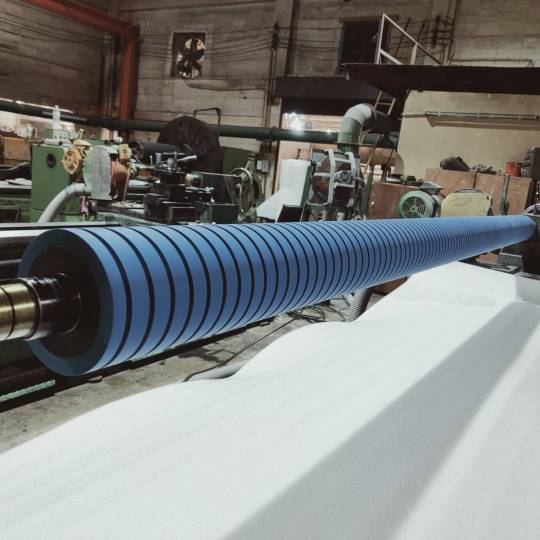
https://empirerollersandcoatings.com is 1 of Australia's many famous native animals and has turn into an iconic image representing aspects regarding Australian life and culture, including getting featured on typically the Australian Coat involving arms, currency in addition to postage stamps.
The particular Kangaroo family is native to Australia and New Guinea although surprisingly there are numerous feral populations from presented species to Brand new Zealand, Hawaii in addition to Great Britain.
The phrase kangaroo is caused by Captain James Cook, who on typically the August 1770 (at that period a Lieutenant) at Cooktown, Quotes made note regarding the local radical word 'gangurru' which usually was transcribed inside the logs of the particular HM Endeavour as 'Kangooroo' or 'Kanguru'.
You can find in overall 69 species of typically the Kangaroo family of which in turn the four key species are the particular Red Kangaroo, the Eastern Grey Kangaroo, the Western Overcast Kangaroo and the particular Antilopine Kangaroo. Just about all have large, effective hind feet plus legs with effective tails, that the dollars (males) will usually sense of balance on and rear up on if fighting. The doe kangaroos (females) have pouches (marsupium) within which to back their joeys. The gestation period with regard to a kangaroo will be 33 days along with a Joey will spend up to 10 months in its mother pouch plus reach sexual maturation between 18 -- 24 months.
Some of the smaller species contain wallabies, wallaroos, quoka's, tree kangaroos and pademelons. Members of the Kangaroo family are usually marsupials from the Macropodoidea family which in turn scientists have divide into two sub-contract groups being typically the Macropodidae (larger footed) and the Potoroidae (smaller footed).
Associates of the Kangaroo family will vary in size kind 500grams to 90 kilograms and possess hoping speeds regarding between 20km (13mph) and 70km (44mph) for shorted miles. Kangaroos are common in numerous Australian regional areas and happen to be often seen close to such tourist places the Central in addition to Northern Victorian neighborhoods of Bendigo, Echuca and Beechworth, Main Australia, Southern NSW, the Northern Terrain and most regarding Western Australia
Typically the kangaroo is broadly significant and capabilities in many factors of existence. They will feature in like film and printing productions as Skippy the Bush Kangaroo, Tom and Jerry, The Merry Song cartoons and Winnie the Pooh. These people also feature inside sporting teams such as the Foreign Rugby team (Kangaroos), Australian Soccer group (Socceroos), Australian Women's Hockey team (Hockeyroos) and the Australian Men's Basketball crew (Boomers) as effectively as a number of various other domestic Australian in addition to international sporting clubs.
Somewhat more controversially, and while the kangaroo has typically been a source of food regarding indigenous Australians, throughout recent years it may be more popular specifically within the European marketplace. Kangaroo's produce a new red meat which is considered to become low in fat and high inside protein and features a strong gamey flavor. Most meat sold for human being consumption is obtained from the pets hind legs. A few kangaroo meat is also processed into canine food.
1 note
·
View note
Photo




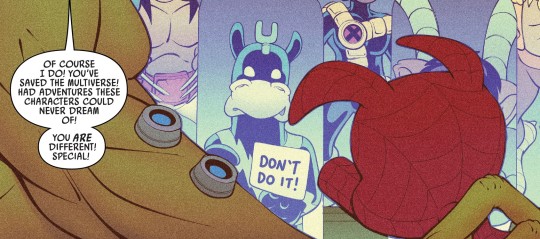
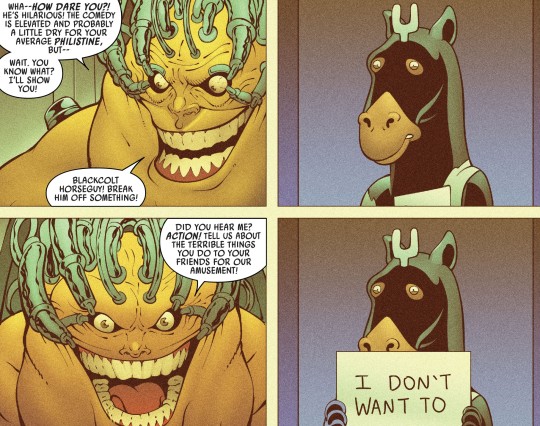


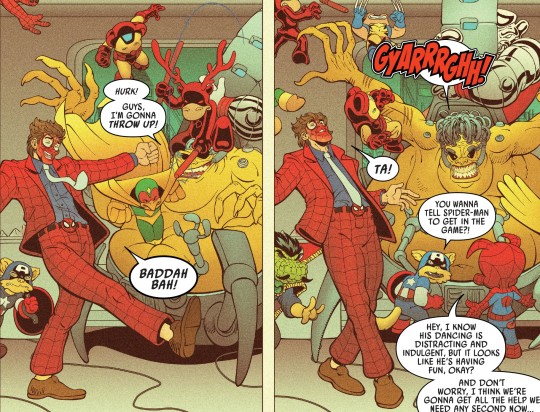
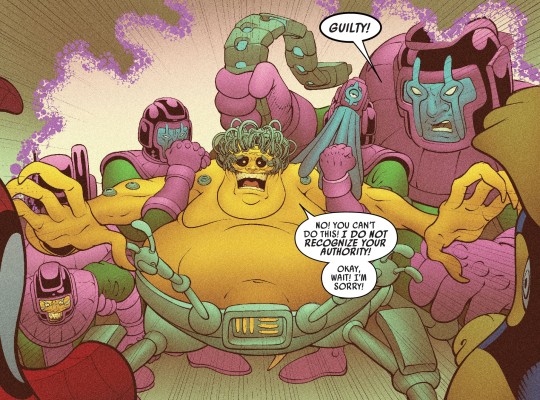
From Spider-Ham #005
Art by Will Robson and Erick Arciniega
Written by Zeb Wells
#spider-ham#peter porker#mary jane waterbuffalo#bufford porker#peggy porker#captain americat#steve mouser#thrr#mojo#spider-man#peter parker#kangaroo the conquerer#croctor strange#steamin strange#sub-marsupial#iron mouse#pigeon#deerdevil#batt burdock#kang the conqueror#nathaniel richards#marvel#comics#marvel comics
27 notes
·
View notes
Text
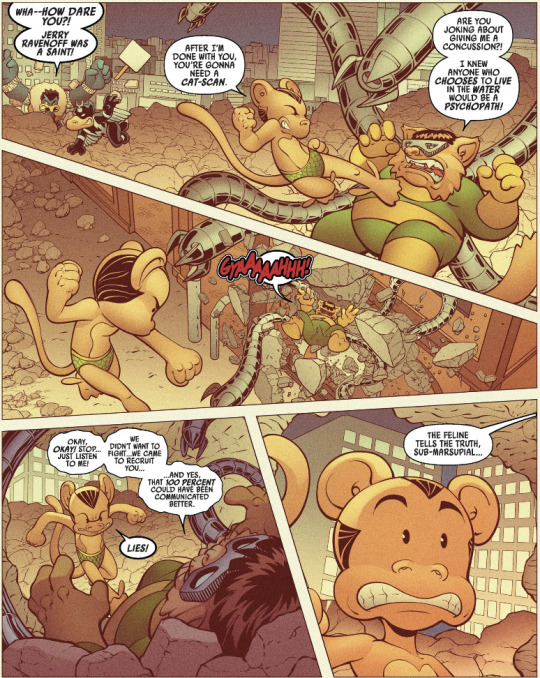
Spider-Ham (Vol.1/2019) #2
2 notes
·
View notes
Photo


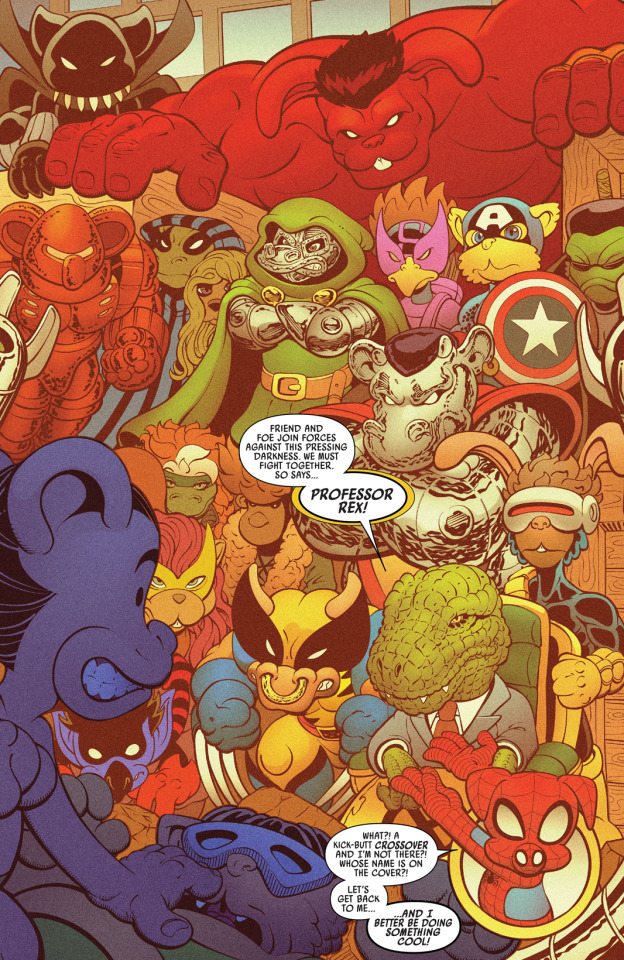
Spider-Ham #2 (2020)
written by Zeb Wells
art by Will Robson & Erick Arciniega
#black colt#raven the hunter#sub marsupial#doctor octopussycat#marvel#wednesday spoilers#comics#wednesday spoiler#spoilers#comic spoilers#comic books spoilers#comic books
150 notes
·
View notes
Text

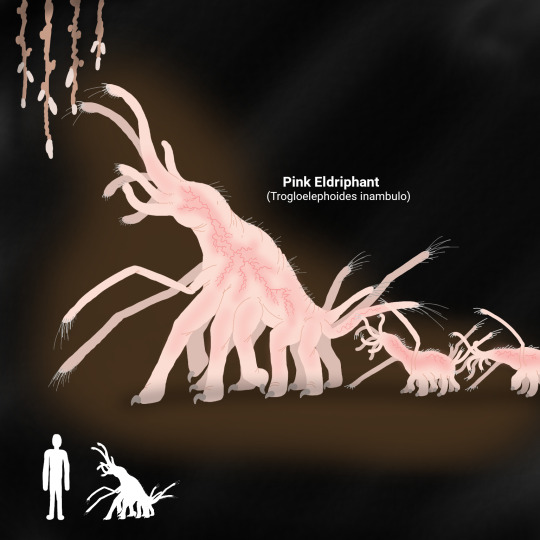
In the Sub-Arcuterran cavern system, food is scarce, and many creatures remain small. The restricted space and scant resources has hindered the development of bigger animals, for millions of years. Yet as the natural procedures of erosion further expand the cavern system into a wide network of tunnels and chambers in multiple layers and shapes, and the inclusion of mocklichens and meatmoss begin to flourish in the abyssal darkness, the strange subterranean world had slowly become increasingly more conducive to the evolution of larger creatures. None of them would quite measure up to the largest megafauna of the outside world: yet, by troglofauna standards, some have gotten very big indeed.
The pink eldriphant (Trogloelephoides inambulo) is one of the largest extant species that roams the caverns: standing over five feet at full height and weighing up to 200 pounds in the bigger specimens, it towers over most other troglofauna which generally average to roughly large rat-size. It is the tallest of a group of large-bodied, fungivorous daggoths known as biblarodons: feasting on the abundant mocklichens and meatmoss, which technically would make them omnivores, growing in great quantities along the floors and walls of the caves, they would in essence fill niches of large grazers on the surface, which in turn would be exploited by the caverns' resident top carnivores, the badger-sized blindmutts.
The pink eldriphant, in particular, has specialized to "browse" on mocklichens and meatmoss that grow higher up on the cave walls and hanging down from the roof, well out of reach of other "grazers". Its longer limbs and nasal tendrils allow it a greater range to reach high up onto walls and overhanging stalactites to find and reach food using sensory hairs on the tendrils and small taste-bud analogs on the tips, allowing it to discern whether the objects it feels are edible or not. Having multiple sensitive appendages is an advantage in the pitch black of the caves, and thus the eldriphant, like all biblarodons, has modified the first two fingers of its forelimbs and the last four fingers of its hindlimbs into long, flexible feelers, which probe about both fore and aft to aid in navigation like walking sticks, while the eldriphant walks about on ten finger-limbs, equipped with hooked claws that both aid in traction as well as for defense, in addition to its sharp incisors.
Eldriphants are highly sociable creatures, seeking safety from predatory blindmutts in groups of up to twenty individuals traveling together as they forage. They communicate through heat signatures, which they achieve by flushing blood vessels on their transluscent, pigment-less skin, giving them a very distinctive bright pink color. Yet as they are blind, like all daggoths, this display is instead detected by fellows using specialized temperature receptors like those of some bats, located on their facial tendrils, allowing them to communicate more discreetly as opposed to scent or sound that can easily alert enemies.
Unusually among daggoths, the pink eldriphant also practices extended parental care, unlike other species that birth tiny marsupial-like offspring that nurse attached to the parent for a few days before dropping off to live an independent quasi-larval lifestyle. Instead, young eldriphants detatch from the mother at a later time, when they are more developed, and continue to follow her around, keeping their facial tendrils in regular contact with her rear feelers to avoid getting lost, and seeking refuge in the midst of her numerous finger-limbs whenever they feel threatened. As the typical eldriphant litter can have as many as eight offspring at a time (which even then pales in comparison to even bigger typical daggoth litters), the young ones in turn form a chain one after the other as they follow their mother, feeling and orienting with each other's rear feelers in turn as they parade along single file through the pitch darkness of the cavernous mazes that they call home.
146 notes
·
View notes